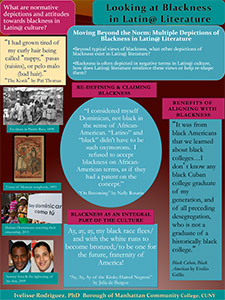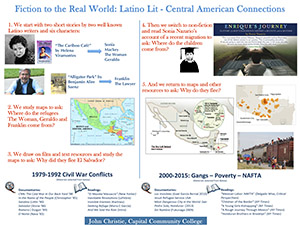Language and Literature
Hispanic Culture: A Humanities Course on Latino Cinema
 This outline for a semester-long course on Latino cinema, by Spanish Language Professor Daniel D’Arpa, Mercer County Community College, is intended as a focus for an existing “Hispanic Culture” course. This course theme will investigate the ways that film and video deal with issues of Latino history in the U.S. The course explores basic American myths regarding Latinos as well as the development of U.S. Latino cultural identity. The course highlights the importance of defining the multiple meanings of the term Hispanic as central for defining learning objectives.
This outline for a semester-long course on Latino cinema, by Spanish Language Professor Daniel D’Arpa, Mercer County Community College, is intended as a focus for an existing “Hispanic Culture” course. This course theme will investigate the ways that film and video deal with issues of Latino history in the U.S. The course explores basic American myths regarding Latinos as well as the development of U.S. Latino cultural identity. The course highlights the importance of defining the multiple meanings of the term Hispanic as central for defining learning objectives.
Looking at Blackness in Latin@ Literature
 This poster, created by Ivelisse Rodriguez, Professor of English at Borough of Manhattan Community College, CUNY, focuses on representations of blackness in Latin@ literature. Numerous literary excerpts from a variety of Latin@ groups are used to explore the different ways blackness is viewed in US Latin@ literature. Literary excerpts from varying time periods trace how attitudes towards blackness shift and/or remain the same. The focus on different Latin@ groups allows us to see how these different groups intersect or diverge because of their unique histories and unique identity constructions. For example, a close reading of Colon’s text in comparison with an examination of racial classification systems used in the US and in Puerto Rico opens discussion of the issues around race and color faced by Puerto Ricans in the continental U.S.
This poster, created by Ivelisse Rodriguez, Professor of English at Borough of Manhattan Community College, CUNY, focuses on representations of blackness in Latin@ literature. Numerous literary excerpts from a variety of Latin@ groups are used to explore the different ways blackness is viewed in US Latin@ literature. Literary excerpts from varying time periods trace how attitudes towards blackness shift and/or remain the same. The focus on different Latin@ groups allows us to see how these different groups intersect or diverge because of their unique histories and unique identity constructions. For example, a close reading of Colon’s text in comparison with an examination of racial classification systems used in the US and in Puerto Rico opens discussion of the issues around race and color faced by Puerto Ricans in the continental U.S.
Literature and Central American Connections
 Over this week-long project created by John Christie, Professor of Literature at Capital Community College, students read selected short stories, poems, and non-fiction to analyze why certain fictional and Central American characters migrated north. Students investigate the historical, political, and social context in Central America in order to deepen and strengthen their understanding of the literary works. Students read and question character motivation, then in class engage in learning more information about the countries of Central America. In the second step, students are asked to apply the historical knowledge to the literature and make connections between real life and the artistic expression. Students are aslo asked to make comparisons between events and writings from the 1980s and the 2010s to understand migration experiences from both periods as well as their literary interpretations.
Over this week-long project created by John Christie, Professor of Literature at Capital Community College, students read selected short stories, poems, and non-fiction to analyze why certain fictional and Central American characters migrated north. Students investigate the historical, political, and social context in Central America in order to deepen and strengthen their understanding of the literary works. Students read and question character motivation, then in class engage in learning more information about the countries of Central America. In the second step, students are asked to apply the historical knowledge to the literature and make connections between real life and the artistic expression. Students are aslo asked to make comparisons between events and writings from the 1980s and the 2010s to understand migration experiences from both periods as well as their literary interpretations.
Latin@s in Labor: Two Stories Diverge
This lesson by Jodi Corbett explores two conflicting stories: Lorraine Collett Petersen’s and Ester Hernandez’s through one iconic image: Sun Maid Raisin. The goal is for the students to understand how messages are “packaged” for consumption and begin the process of becoming producers of a visual argument. Download Lesson
On Being Foreign
In this lesson by Aránzazu Borachero students will examine the concept of “foreignness” through selected excerpts of Cabeza de Vaca’s Relación, and will make comparisons and connections with present day ideas of foreignness in the United States. Download Lesson